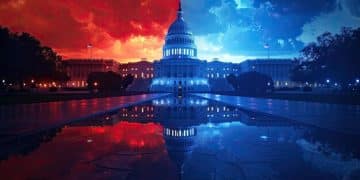Dodd-Frank Act Changes: Impact on US Financial Sector

The proposed changes to the Dodd-Frank Act could significantly reshape the regulatory landscape for the US financial industry, potentially altering banking operations, consumer protection, and market stability through revised capital requirements, oversight mechanisms, and resolution authorities.
The financial world is dynamic, constantly evolving in response to economic shifts and legislative adjustments. Among the most significant pieces of legislation to shape the modern US financial landscape is the Dodd-Frank Wall Street Reform and Consumer Protection Act, enacted in the wake of the 2008 financial crisis. As discussions about its potential modifications continue, understanding how will the proposed changes to the Dodd-Frank Act affect the financial industry in the US becomes paramount for institutions, regulators, and the public alike. This exploration delves into the intricate layers of these proposed alterations and their broad implications.
Understanding the Dodd-Frank Act’s Original Intent
The Dodd-Frank Wall Street Reform and Consumer Protection Act, signed into law in 2010, was a monumental piece of legislation. Its primary objective was to prevent a recurrence of the 2008 financial crisis by instituting systemic reforms. The Act aimed to enhance accountability and transparency within the financial system, protect consumers, and end the “too big to fail” problem, which saw large financial institutions bailed out by taxpayers.
At its core, Dodd-Frank introduced a sweeping overhaul of financial regulation. It established new agencies, such as the Consumer Financial Protection Bureau (CFPB), and expanded the powers of existing ones. The Act mandated stricter capital requirements for banks, regulated derivatives, and created a framework for winding down failing financial institutions without resorting to taxpayer-funded bailouts. These measures profoundly impacted banking, investment, and consumer lending, fundamentally altering how financial services operated in the United States.
Key Pillars of the Original Act
The Dodd-Frank Act comprised numerous provisions, but several stood out for their profound impact. These pillars formed the foundation of its regulatory approach, aiming to address the systemic risks that contributed to the 2008 crisis. Their collective implementation sought to create a more resilient and transparent financial system, fostering public trust and economic stability.
- Enhanced Prudential Standards: Imposed tougher capital and liquidity requirements on large banks, intended to absorb losses and prevent systemic shock.
- Orderly Liquidation Authority (OLA): Established a mechanism for the government to take over and dismantle failing financial firms, mitigating risks to the broader economy.
- Consumer Financial Protection Bureau (CFPB): Created an independent agency dedicated to consumer protection in the financial sector, overseeing mortgages, credit cards, and other financial products.
- Volcker Rule: Restricted proprietary trading by banks, aiming to separate speculative activities from traditional banking functions to reduce risk.
The Act’s comprehensive nature meant that virtually every aspect of the financial industry, from the largest investment banks to regional credit unions, felt its effects. While lauded by some for preventing future crises, others criticized it for imposing an undue regulatory burden, particularly on smaller institutions. This ongoing debate forms the backdrop for the current discussions about its potential changes.
Drivers Behind Proposed Dodd-Frank Amendments
Despite its broad objectives, the Dodd-Frank Act has been the subject of ongoing debate and calls for reform almost since its inception. The perceived burdens on financial institutions, particularly smaller community banks, have been a significant point of contention. Critics argue that the Act’s one-size-fits-all approach unduly stifled growth and lending, creating an uneven playing field.
The push for changes often stems from a desire to reduce regulatory complexities and compliance costs, which proponents argue divert resources from productive investments and client services. Furthermore, some argue that certain provisions, while well-intentioned, have inadvertently made the financial system less competitive or have not achieved their intended goals efficiently. These arguments gain traction, especially among those who believe the post-crisis environment has evolved sufficiently to warrant a more tailored regulatory approach.
Calls for Regulatory Relief for Smaller Banks
One of the most vocal segments calling for adjustments to Dodd-Frank has been community banks and smaller regional institutions. They argue that the extensive compliance requirements, originally designed for megabanks whose failures could trigger systemic crises, are disproportionately burdensome for them. This burden, they contend, limits their ability to lend to small businesses and individuals, thereby hindering local economic growth.
Proposals often center on tailoring regulations based on bank size and complexity, ensuring that the oversight is commensurate with the perceived risk. This ‘tiering’ of regulations aims to strike a balance between maintaining financial stability and fostering a competitive environment for a diverse range of financial institutions. The goal is to free up capital and resources for these smaller entities, allowing them to better serve their local communities.
Other key drivers for proposed changes include a general desire for deregulation within certain political circles and an evolving understanding of financial risks. As the economy recovers and new technologies emerge, the relevance and effectiveness of some Dodd-Frank provisions are continually re-evaluated. These forces converge to drive the ongoing discussions and legislative efforts aimed at modifying the landmark financial reform act, reflecting a continuous effort to optimize the regulatory framework for the financial industry.

Potential Impacts on Banking Institutions
Any significant changes to the Dodd-Frank Act would inevitably ripple through the banking sector, affecting institutions of all sizes in diverse ways. Large, systemically important financial institutions (SIFIs) would likely experience shifts in their capital requirements and oversight, potentially freeing up capital for investment or share buybacks. For smaller and mid-sized banks, the impact could be even more transformative, as reduced regulatory burdens might allow them to reallocate resources towards growth and lending initiatives.
The overall regulatory environment would shift, potentially leading to varied responses from banks. Some might embrace new opportunities for risk-taking if specific restrictions are eased, while others might maintain a more conservative stance, valuing stability over aggressive expansion. The degree of impact would largely depend on the specific provisions altered and the extent of those changes, demanding careful strategic planning from banking leadership.
Capital and Liquidity Requirements
One of the most consequential areas of potential change lies in the capital and liquidity requirements imposed on banks. Dodd-Frank significantly increased these buffers to ensure banks could withstand economic shocks. Should these requirements be relaxed, particularly for larger institutions, it could free up substantial capital. This capital could then be deployed in various ways, such as increased lending, investments in new technologies, or returning value to shareholders through dividends and stock repurchases.
However, a loosening of these standards could also raise concerns about financial stability. Critics of such changes argue that lower capital buffers could increase systemic risk, making banks more vulnerable to downturns. The debate centers on finding an optimal balance that fosters economic growth without compromising the resilience of the financial system. The outcome of these discussions will directly influence balance sheets and risk management strategies across the banking industry, potentially altering lending practices and market behavior.
Furthermore, changes to capital requirements might disproportionately benefit larger banks if the adjustments are not finely tuned. Smaller institutions, which often face different risk profiles and operational complexities, might not see the same relative benefits. This could inadvertently exacerbate the competitive landscape, making it harder for community banks to compete with their larger counterparts. Thus, the specific design of any revised capital and liquidity frameworks will be crucial in shaping the future dynamics of the US banking sector.
Implications for Consumer Protection and Investment
The Dodd-Frank Act profoundly impacted consumer protection, chiefly through the creation of the Consumer Financial Protection Bureau (CFPB). Any proposed changes to the Act, particularly those affecting the CFPB’s powers or funding, would directly influence its ability to safeguard consumers against unfair, deceptive, or abusive financial practices. A weakened CFPB could potentially expose consumers to greater risks in areas like mortgages, credit cards, and student loans, reversing a decade of enhanced oversight.
The investment landscape would also see significant shifts. The Volcker Rule, for instance, restricted proprietary trading by banks. If this rule were relaxed or repealed, it could allow banks to engage in more expansive trading activities, potentially increasing profits but also reintroducing some of the risks Dodd-Frank aimed to mitigate. This re-engagement in speculative activities could reshape market dynamics, influencing liquidity, volatility, and the types of financial products offered to investors.
Derivatives and Systemic Risk Assessment
Dodd-Frank brought the sprawling, opaque over-the-counter (OTC) derivatives market under significant regulation, requiring central clearing and exchange trading for many derivatives. The aim was to increase transparency and reduce systemic risk. Proposed changes might alter these requirements, potentially easing compliance burdens for market participants. While this could lower costs, it might also reduce the transparency and regulatory oversight that were central to mitigating risk in these complex financial instruments.
Moreover, the Act mandated rigorous systemic risk assessments for large financial institutions. Modifications to these assessment criteria or the powers of agencies like the Financial Stability Oversight Council (FSOC) could change how systemic risks are identified and managed. A less stringent approach might be welcome by some institutions seeking to reduce regulatory scrutiny, but it could also lead to a blind spot regarding emerging threats to financial stability. The balance between reducing regulatory drag and maintaining robust systemic protections is delicate, and any shift could have far-reaching consequences for investors and the overall financial system.
Finally, the interplay between changes in banking regulations and investment practices is critical. If banks are allowed to engage in more speculative activities, this could influence the availability and cost of capital for various investment types. It could also lead to new financial products and services, but with potentially different risk profiles for both institutions and individual investors. Thus, any amendments to Dodd-Frank carry significant implications not only for the stability of the financial system but for the protection of average consumers and the opportunities available to investors.
Impact on Financial Stability and Economic Growth
The Dodd-Frank Act’s central purpose was to enhance financial stability and prevent another crisis. Proposed changes inevitably raise questions about how they might affect this stability. Advocates for reform often argue that certain provisions, while promoting stability, have inadvertently stifled economic growth by imposing excessive regulatory burdens. They contend that a more tailored and less restrictive regulatory environment could unlock capital, stimulate lending, and encourage investment, ultimately fueling economic expansion.
Conversely, critics warn that rolling back key Dodd-Frank provisions could reintroduce the very risks the Act sought to mitigate. A perceived reduction in oversight or capital buffers might make the financial system more fragile, increasing its susceptibility to future shocks. The challenge lies in finding a regulatory sweet spot that supports robust economic growth without compromising the fundamental stability of the financial system, a balance that remains a subject of intense debate among policymakers and economists.
Tailoring vs. Uniformity in Regulation
A significant philosophical divide in the debate over Dodd-Frank changes revolves around regulatory tailoring versus uniformity. The original Act largely applied universal standards to financial institutions, aiming for broad compliance. However, proponents of change argue for tailoring regulations based on the size, complexity, and risk profile of institutions. This approach suggests that a small community bank poses a different systemic risk than a global investment bank and should be regulated accordingly.
If tailoring becomes more prevalent, it could lead to a more efficient allocation of regulatory resources and potentially reduce compliance costs for smaller entities. However, it also introduces complexities and potential loopholes. A fragmented regulatory landscape might make it harder to identify and address emerging systemic risks that cut across different types of institutions. The shift from uniformity to tailoring reflects a broader trend in financial regulation towards risk-based supervision, balancing prudence with adaptability.
The long-term effects on economic growth are speculative and depend on the specific nature of any changes. A truly balanced approach that reduces undue burdens while preserving essential safeguards could indeed foster growth. However, an overhaul that significantly weakens protections could lead to another cycle of boom and bust, ultimately hindering sustainable economic development. The economic outcomes will be a critical measure of whether the proposed changes achieve their stated goals or inadvertently sow the seeds for future instability.
The Political Landscape and Path Forward
The trajectory of proposed changes to the Dodd-Frank Act is deeply intertwined with the prevailing political environment. Legislation of this magnitude typically requires bipartisan consensus, which can be elusive in a highly polarized political climate. The degree of support for deregulation often shifts with changes in administration and congressional control, making the path forward unpredictable. Different political factions hold divergent views on the optimal level of financial regulation, creating a complex legislative dance.
Understanding the balance of power in Congress, the priorities of the executive branch, and the lobbying efforts of financial industry stakeholders is crucial to anticipating the likelihood and nature of future amendments. Even if broad agreement on the need for some changes exists, the specifics often become points of contention, requiring extensive negotiation and compromise. This intricate political process shapes not only what changes are proposed but also which ones ultimately become law, determining their impact on the financial sector.
Regulatory Agencies’ Role in Implementation
Beyond legislative action, regulatory agencies play a pivotal role in implementing and interpreting any changes to the Dodd-Frank Act. Agencies such as the Federal Reserve, the Office of the Comptroller of the Currency (OCC), the Federal Deposit Insurance Corporation (FDIC), and the Securities and Exchange Commission (SEC) are responsible for drafting and enforcing the detailed rules that operationalize the legislation.
Even without explicit legislative amendments, these agencies can influence the Act’s impact through their regulatory focus, enforcement priorities, and interpretations of existing rules. A change in leadership or philosophical approach within these agencies can lead to significant shifts in how financial institutions are supervised. Therefore, tracking not only congressional debates but also the activities and guidance issued by these regulatory bodies is essential for understanding the evolving landscape of financial regulation in the US. Their actions, often more nuanced and immediate than legislative changes, will significantly shape how proposed modifications to Dodd-Frank ultimately affect the financial industry.
The interplay between legislative intent and regulatory implementation will largely determine the true impact of any reforms. A proposed change might appear significant on paper, but its practical effects will depend on the detailed rules written by agencies and how they choose to enforce them. This layered approach to financial governance ensures a continuous evolution of the regulatory framework, responding to both political will and market realities.
Examining Case Studies and Precedents
To fully grasp the potential impact of changes to the Dodd-Frank Act, it is valuable to examine historical precedents and specific case studies where significant financial regulations were either introduced or altered. The legislative history of financial markets in the US is replete with examples of reforms enacted in response to crises, which in turn generated debates about their long-term efficacy and unintended consequences. Analyzing these instances provides critical insights into how similar legislative adjustments might play out.
For instance, the deregulation waves of the 1980s and 1990s, culminating in the Gramm-Leach-Bliley Act of 1999, which repealed parts of the Glass-Steagall Act, offer a complex precedent. While these changes were intended to foster competitiveness and innovation in financial services, some argue they also contributed to the conditions that led to the 2008 crisis. These historical examples underscore the delicate balance between fostering growth and maintaining stability, providing a cautionary tale for modern legislative efforts.
Lessons from Taming “Too Big To Fail”
One of Dodd-Frank’s central aims was to end the “too big to fail” problem, creating mechanisms like the Orderly Liquidation Authority (OLA) to resolve failing SIFIs without taxpayer bailouts. The effectiveness of these provisions has been debated, particularly as no truly large financial institution has been subjected to OLA since the Act’s passage. However, the mere existence of these powers is believed by some to have positively influenced market discipline, encouraging larger banks to hold more capital and manage risk more prudently.
Proposed changes to OLA or to the systemic risk assessment framework would be particularly impactful. Relaxing these provisions could be seen as a return to an environment where large institutions are perceived as implicitly backstopped by the government, potentially encouraging excessive risk-taking. Conversely, a more streamlined resolution process, if achieved, could reduce uncertainty during times of financial stress. The ultimate efficacy of these changes will be measured by their ability to manage systemic risk while avoiding the moral hazard associated with past bailout scenarios.
Furthermore, studying international regulatory reforms adopted by other major economies post-2008 can offer comparative insights. While regulatory frameworks vary, the shared goal of financial stability means that lessons learned abroad can inform domestic policy debates. These case studies, combined with critical analysis of the Dodd-Frank Act’s decade-long operational history, provide a robust empirical foundation for evaluating the likely ramifications of any proposed legislative amendments on the US financial industry.
| Key Aspect | Potential Impact |
|---|---|
| 📊 Capital Requirements | May be eased, freeing up capital for banks but potentially increasing systemic risk. |
| 🛡️ Consumer Protection (CFPB) | Powers potentially reduced, affecting consumer safeguards in financial products. |
| 📉 Volcker Rule | Relaxation could permit more proprietary trading, impacting bank profits and risk exposure. |
| 🏦 Community Banks | Likely to see reduced regulatory burdens, potentially boosting local lending. |
Frequently Asked Questions about Dodd-Frank Act Changes
▼
The primary goal of the Dodd-Frank Act, enacted in 2010, was to improve accountability and transparency in the financial system, protect consumers from abusive financial practices, and end the issue of “too big to fail” by creating mechanisms to resolve failing institutions without taxpayer bailouts. It aimed to prevent a recurrence of the 2008 financial crisis through comprehensive reforms across various aspects of finance.
▼
Changes to the Dodd-Frank Act could significantly impact consumer protection, especially if provisions related to the Consumer Financial Protection Bureau (CFPB) are altered. Weakening the CFPB’s powers or funding could reduce its ability to oversee financial products like mortgages and credit cards, potentially exposing consumers to more risks. Conversely, some proposals aim to streamline regulations without compromising core consumer safeguards.
▼
The concern that “too big to fail” could return is a central point of debate. Proposed changes aim to tailor regulations, particularly for smaller banks, but some critics worry that easing rules for large, systemically important financial institutions might inadvertently lessen the protections designed to prevent another crisis, like stricter capital requirements or orderly liquidation authority. The balance is delicate and heavily scrutinized.
▼
The Volcker Rule is a key provision of Dodd-Frank that restricts banks from engaging in certain proprietary trading activities and owning or investing in hedge funds or private equity funds. Proposed changes could simplify or relax this rule, potentially allowing banks more freedom in their investment strategies. This could increase bank profitability but also reintroduce some of the speculative risks it was designed to mitigate, impacting market stability.
▼
Community banks are often cited as beneficiaries of proposed changes due to the disproportionate regulatory burden they faced under Dodd-Frank. Easing compliance requirements, such as reporting rules or specific capital thresholds, could free up resources for these smaller institutions. This could enable them to increase lending to local businesses and consumers, potentially stimulating economic growth in their communities and enhancing their competitiveness.
Conclusion
The discussions surrounding proposed changes to the Dodd-Frank Act represent a complex and multifaceted debate with profound implications for the US financial industry. From the largest banks to individual consumers, every segment of the financial ecosystem stands to be affected by these potential shifts. Striking a balance between fostering economic growth, reducing regulatory burden, and maintaining robust financial stability remains the central challenge for policymakers. As these debates unfold, the ultimate impact will depend not only on the legislative details but also on their nuanced implementation by regulatory agencies. Vigilance and informed analysis will be key to navigating this evolving landscape, ensuring that any reforms serve the long-term health and resilience of the American financial system.





